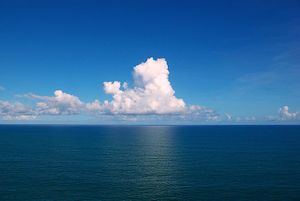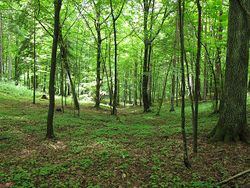Carbon sink

A carbon sink is a land or ocean mass that can take in carbon - most notably carbon dioxide - from the atmosphere. It is the opposite of a carbon source, which acts to emit carbon into the atmosphere, such as a motor vehicle or a coal-fired power plant. Carbon sources cause negative impacts to the earth as they emit carbon from below the Earth's surface that would otherwise not enter the atmosphere.
Carbon sinks are a vital part of the carbon cycle, as they regulate the carbon in the atmosphere via processes like photosynthesis or absorption through pressure differences.[2]
The Earth's largest carbon sinks are naturally occurring, that being the ocean's, soil and plant life. There are also artificial carbon sinks, including carbon capture and storage methods and landfills.[3]
Ocean Sink and Acidification
The ocean is a tremendous carbon sink that makes use of pressure differences between its gas contents and that of the atmosphere. Particles are exchanged through this pressure difference until equilibrium is reached between the two systems. As carbon dioxide levels increase in the atmosphere, as they have been, the ocean and atmosphere must re-equilibrate. This has increased carbon dioxide levels in the ocean's surface layers.[2]
Measurements over recent years have indicated an increase of carbon dioxide in the surface layers of the oceans by 1.6-1.9 ppm per year, which is in accordance with the atmospheric increase of 1.5-1.9 ppm/year.[2]
Although the ocean takes out carbon from the atmosphere that would otherwise contribute to global warming, there are adverse effects due to this process. Increased dissolved carbon dioxide levels raise the acidity of the water, and this is known as ocean acidification. The average pH of the ocean has already decreased by around 0.1 since the industrial era (decrease in pH means more acidity), which is and continues to affect many organisms in negatively.
Are forests carbon sinks?

Many simply assume that trees and other plant life solely act to remove carbon dioxide from the atmosphere, however this isn't the entire story. The quick answer to "are forests carbon sinks?" is it depends. A better term for trees and other plants is to categorize them as carbon pools - these are reservoirs of carbon that have the capacity to both take in and release carbon.[5]
Plants take in carbon dioxide in the process of photosynthesis, making them carbon sinks in this context since this removes CO2 from the atmosphere, however they also emit carbon dioxide through respiration, decomposition and combustion (when they are burned), making them a source as well.[5] The cycling of carbon in this pool is generally balanced, however there is a way to temporarily tip this balance. When plants expand their area, for example when trees are planted, the new trees take in more carbon than they output, resulting in more carbon being taken from the atmosphere. This only works on a relatively small time scale of around 50 years, since as trees grow older the balance of intake and output is restored.
The idea of planting trees is therefore by no means a solution to increasing CO2 levels, yet it is still often a good thing to do. Moreover, protecting existing forests is crucial, and climate specialists consider this as the "best strategy for sink maintenance", with reasoning that forests and their soil act as excellent carbon storage areas, as well as preserving the biodiversity associated with their existence.[5]
For Further Reading
- Carbon cycle
- Carbon pool
- Greenhouse gas
- Greenhouse effect
- Carbon capture and storage
- Or explore a random page
References
- ↑ Wikimedia Commons [Online], Available: https://upload.wikimedia.org/wikipedia/commons/e/e0/Clouds_over_the_Atlantic_Ocean.jpg
- ↑ 2.0 2.1 2.2 M. Melieres and C. Marechal, "The Impact of Warming on the Ocean," in Climate Change: Past, Present and Future 1st ed., U.K.: Wiley, 2015, ch.27, pp.273
- ↑ EPA. (Accessed October 31, 2015). Landfill Carbon Storage in EPA’s Waste Reduction Model [Online], Available: http://www3.epa.gov/warm/pdfs/landfill-carbon-storage-in-warm10-28-10.pdf
- ↑ Wikimedia Commons [Online], Available: https://upload.wikimedia.org/wikipedia/commons/c/c3/Podlaskie_-_Czarna_Bia%C5%82ostocka_-_Puszcza_Knyszy%C5%84ska_-_G%C3%B3ry_Czuma%C5%BCowskie_-_E_-_v-NW.JPG
- ↑ 5.0 5.1 5.2 Food and Agriculture Organization of the United Nations. Forests and Climate Change [Online], Available: http://www.fao.org/docrep/005/ac836e/AC836E03.htm

